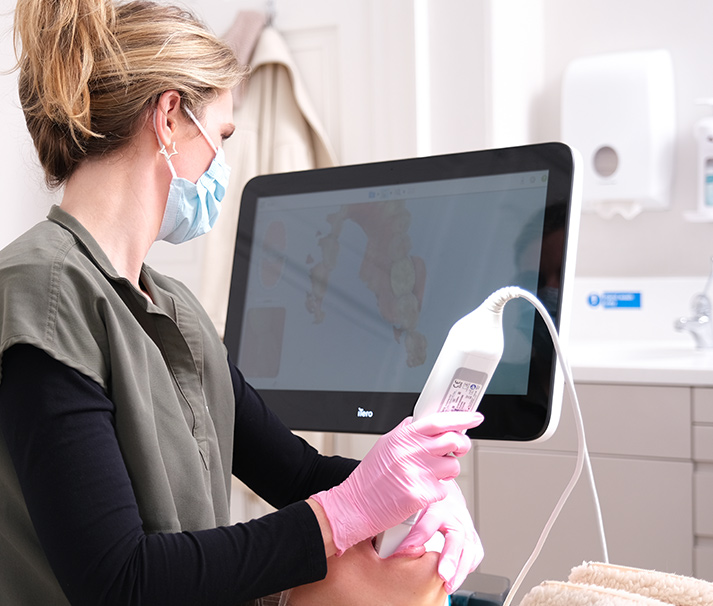
All Options Open
No two smiles are the same—and everyone’s journey to fulfilment is as unique as your smile itself.
That’s why we offer discreet fixed braces alongside Invisalign® clear aligners.
Tried and tested fixed braces still have their place in treatment, especially for treating more complex cases.
And, if you’re worried about steel hardware drawing attention to your treatment, you’ll be pleased to know that newer fixed appliances feature tooth-coloured brackets and translucent wires for improved discretion.
BOOK CONSULTATIONStraightforward from Start to Finish
Your orthodontic journey on The Row starts with a consultation from our team, led by specialist Dr Nirmal Shah.

FIND OUT WHAT IT’S ALL ABOUT
We’ll chat with you to understand your concerns, find out more about your desired outcome, and explore which type of treatment will suit you best.
We’ll then design a bespoke treatment plan comprising treatments from our orthodontic range, including Invisalign®, lingual (behind-the-teeth) braces, conventional fixed braces and more.
We can also let you know about complementary cosmetic procedures like whitening, bonding, and veneers to complete your treatment.

Tried. Tested. Effective
While they may lack some of clear aligners’ popularity and cool factor, fixed braces have many years of evidence proving their effectiveness against almost any orthodontic challenge.
The science behind fixed braces is simple: Appliances consist of a series of discreet brackets affixed to the teeth, linked by fine wires.
Making tiny incremental adjustments to tighten (ligate) the wire brings each tooth gradually closer to the perfect position.
The process takes time, but the results are worth the wait!
MEET OUR SPECIALIST ORTHODONTIST

DR NIRMAL SHAHSPECIALIST ORTHODONTIST
Orthodontic treatments on The Row are headed by specialist Dr Nirmal Shah, an honourary clinical tutor at Dundee Dental School and Birmingham College of Medicine and Dentistry.
With years of experience in orthodontics at the highest level, Nirmal has a stellar success rate using fixed braces and other appliances to correct complex challenges such as TMJ conditions and facial irregularities.
Nirmal also supports children and young people in growing confidently with early and interceptive orthodontics.
Brace Yourself for Outstanding Care!
Contact us to arrange your consultation with Nirmal and the team.
BOOK CONSULTATIONFrequently Asked Questions
Is specialist orthodontics suitable for children?
Orthodontic treatment can begin in children as early as 9 years old, although the ideal time to start treatment will vary depending on the individual child’s needs and the type of orthodontic issue they are experiencing.
In general, it’s a good idea to have a child evaluated by a specialist orthodontist around the age of 9 so that any potential orthodontic issues can be identified early on.
Early orthodontic treatment can help guide the growth and development of a child’s jaw and teeth, ultimately leading to better outcomes and a shorter overall treatment time. However, many orthodontic issues are best addressed during adolescence, when all permanent teeth have come in and the jaw has finished growing.
Ultimately, the decision of when to start orthodontic treatment will depend on each child’s specific needs, as determined by their specialist orthodontist.
Take a look at our children’s orthodontics page for more information.
How long are fixed braces on?
The length of time that fixed braces are worn can vary depending on the individual case and the severity of the misalignment.
Typically, fixed braces are worn for 1-2 years. However, in some cases, the treatment can take longer or shorter than this. It is essential to follow your orthodontist’s advice regarding the time needed to wear fixed braces and attend all scheduled appointments to ensure the best possible outcome.
Do fixed braces hurt?
Fixed braces can cause discomfort, especially in the first few days after they are applied or after an adjustment. This is because the braces are gradually shifting the teeth into their correct positions, which can put pressure on the teeth and surrounding tissues.
However, the level of discomfort can vary from person to person. Some people experience only mild discomfort, while others may experience more significant pain.
Factors such as the severity of the orthodontic problem being treated, your pain tolerance, and how well you follow your orthodontist’s instructions can all play a role.
Discomfort caused by fixed braces tends to subside after a few days. It can usually be managed with over-the-counter pain medications such as paracetamol or ibuprofen.
We’ll provide more specific information and advice based on your individual situation.
How do fixed braces work?
Fixed braces consist of brackets, wires, and elastic bands, which apply gentle, constant pressure on your teeth, causing them to move gradually.
The brackets are small metal or ceramic squares bonded to each tooth using a special dental adhesive. The wire, also known as an archwire, is threaded through each bracket and secured using elastic bands or small metal ties.
The archwire applies pressure to the brackets, which in turn applies pressure to the teeth. As the teeth move, the wire is adjusted or changed regularly by the orthodontist to maintain the correct amount of pressure needed to continue the movement of the teeth.
The elastic bands or metal ties can also be adjusted to help move specific teeth in a particular direction. Over time, the constant pressure applied by the braces causes the bone surrounding the teeth to reshape, allowing the teeth to move into their correct positions.
This process typically takes 1.5 to 2 years. However, the length of treatment can vary depending on the severity of the dental issues being corrected.
Do fixed braces damage your teeth?
Fixed braces, or traditional braces, do not damage your teeth if properly installed and maintained. In fact, they can help improve the health of your teeth and gums.
However, there are some risks associated with braces if they are not properly cared for or if they are installed incorrectly. For example, if the brackets and wires are not properly cleaned, they can lead to tooth decay and gum disease.
In addition, if the wires are too tight, they can cause discomfort and even damage the enamel on your teeth. To avoid these risks, working with a qualified specialist orthodontist with experience installing and maintaining braces is essential.
We’ll provide detailed instructions on properly caring for your braces and avoiding any potential complications.
Do fixed braces increase the chance of decay?
Fixed braces do not cause tooth decay directly. However, they can make it harder to clean your teeth and may increase the risk of developing tooth decay or gum disease if proper oral hygiene is not maintained.
When you have braces, it’s essential to be diligent about brushing and flossing regularly. Food particles and plaque can easily get trapped in the brackets and wires, making it harder to clean your teeth thoroughly. This can lead to the build-up of harmful bacteria, which can eventually cause tooth decay.
To reduce the risk of tooth decay during orthodontic treatment, it’s essential to maintain a consistent oral hygiene routine that includes brushing and flossing regularly, using fluoride toothpaste, and attending regular check-ups with your dentist.
We may also recommend additional tools, such as interdental brushes or water flossers, to help you clean around your braces more effectively.
Are fixed braces better than Invisalign®?
The choice between fixed braces and Invisalign® depends on several factors, such as the severity of the orthodontic issue, personal preferences, lifestyle, and budget. Both options have advantages and disadvantages, and the best choice for a particular individual can vary.
Fixed braces use metal brackets and wires to straighten teeth and correct bite issues. They are generally more effective in treating complex orthodontic problems, such as severe crowding, crossbites, and open bites.
Fixed braces are also less expensive than Invisalign and do not require as much discipline from the patient to wear them consistently.
Invisalign®, on the other hand, uses a series of clear plastic aligners to gently shift teeth into their correct position. They are nearly invisible and are a popular choice for people who do not want the aesthetic look of metal braces.
Invisalign® aligners are removable, making it easier to clean teeth and eat comfortably. They also require fewer clinical visits than traditional braces. Ultimately, the choice between fixed braces and Invisalign® should be made in consultation with an orthodontist or dentist who can evaluate your specific orthodontic needs and determine the most effective and practical option.










